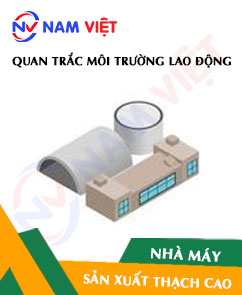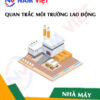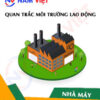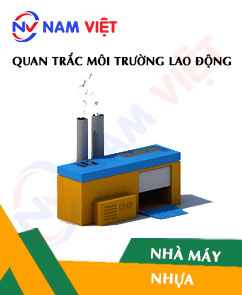Occupational environment monitoring at the gypsum factory
99,000 ₫
Note: The above price is calculated for one sample, the price may vary depending on the area of the environment that needs monitoring and the movement of the market. For more accurate price support, please refer to the quotation table or contact directly with our consulting staff.
Environmental monitoring of a gypsum factory is a session of collecting, analyzing, and evaluating factors in the workplace that may harm workers health.
Table of Contents
Toggle1. Overview of Gypsum Production Factory
a. What is a Gypsum Production Factory?
Factory producing gypsum is a specialized industrial facility that manufactures and fabricates products from gypsum material. Gypsum is a construction material made from calcium sulfate dihydrate (CaSO4·2H2O). It has fire-resistant, soundproof, and thermal insulation properties, and is easy to process.

b. Production processes in a gypsum production factory
The production processes in a gypsum production factory generally include the following steps:
- Raw material extraction and processing: This step involves extracting gypsum from quarries and performing initial processing to separate layers and clean the raw material.
- Grinding and classification: After cleaning, gypsum is ground into powder using crushers. The powder is then classified by particle size to ensure product quality and uniformity.
- Mixing and melting: Classified gypsum powder is mixed with water to form a gypsum mixture. This mixture is then heated in a kiln to melt into a homogeneous liquid.
- Forming and pressing: The molten gypsum is poured into molds to shape gypsum boards. Pressing removes excess water and gives the boards strength.
- Drying and final processing: Pressed boards are dried in kilns to remove all moisture. After drying, boards can be cut, polished, or processed as required to create the final product.
- Packing and transportation: Finished gypsum products are packed and prepared for transport to construction sites or distribution locations.

c. Machinery used in a gypsum production factory
Common machinery used in a gypsum production factory includes:
- Grinders: Used to crush and grind gypsum into powder.
- Forming and pressing machines: Used to shape and press gypsum powder into boards of desired size and shape.
- Melting kiln: Used to melt the gypsum-water mixture into a homogeneous liquid.
- Drying kiln: Used to remove excess water and dry pressed gypsum boards.
- Cutting and processing machines: Used to cut, polish, or process dried boards to create final products.
- Packing machines: Used to pack finished gypsum products before transport.

d. Occupational diseases for workers in a gypsum production factory
Workers in a gypsum production factory may be exposed to factors that can cause occupational diseases. Common occupational diseases in gypsum production include:
- Lung diseases related to gypsum dust: Workers exposed to gypsum dust may experience respiratory problems such as pneumonia, rhinitis, sinusitis, and lower lung diseases.
- Skin diseases: Handling gypsum during production can cause skin irritation, dermatitis, eczema, and other skin problems.
- Hand and wrist disorders: Repetitive activities and mechanical tool use can lead to tendonitis, ligament inflammation, and musculoskeletal disorders in the wrists.
- Hearing problems: Noise during gypsum production can harm workers’ hearing, causing hearing loss and other auditory issues.
- Heat exposure: Certain tasks may involve high temperatures, posing a risk of burns or heat-related injuries.
To prevent occupational diseases, it is essential to implement labor protection measures and comply with safety and hygiene regulations. Workers should be provided with personal protective equipment, instructed on proper tool and equipment use, and follow procedures to control dust, noise, and heat exposure.

e. Common types of gypsum on the market
Various types of gypsum are used for different purposes. Common types include:
- Construction gypsum: Mainly used for building materials including gypsum walls, ceilings, and soundproofing materials. Construction gypsum is durable and fire-resistant.
- Decorative gypsum: Used for decorative products such as ornamental ceilings, decorative walls, sculptures, and panels. Decorative gypsum is flexible in shaping and can be painted or finished for aesthetic effects.
- Medical gypsum: Used in medical applications such as X-ray molds and dental molds.
- Industrial gypsum: Used in fertilizers, explosives, and other chemical products.
- Toy manufacturing gypsum: Some toys, particularly models and assembly kits, are made from gypsum.
2. Overview of Occupational Environment Monitoring Services
a. What is occupational environment monitoring at a gypsum production factory?
Occupational environment monitoring at a gypsum production factory involves collecting, evaluating, and analyzing measurement indicators of workplace environmental factors, to implement timely measures that minimize harm to workers’ health and prevent occupational diseases. This monitoring is mandatory for all gypsum production factories.
Occupational environment monitoring is crucial for protecting and enhancing workers’ health, as workers are the main resource generating profit for the business. Workers frequently exposed to occupational hazards beyond permissible limits can experience health issues and develop occupational diseases.
REGISTER FOR OCCUPATIONAL ENVIRONMENT MONITORING SERVICE
b. An Toan Nam Viet’s occupational environment monitoring program
An Toan Nam Viet’s occupational environment monitoring program is developed by engineers specialized in labor safety and environmental protection. The program uses modern measurement methods to monitor air quality, water, microclimate, physical factors, dust, and other workplace conditions. This program is crucial for ensuring a safe working environment and protecting workers’ health.
Additionally, An Toan Nam Viet’s program helps research and develop new solutions to improve workplace environmental quality. With the dedication and expertise of its monitoring specialists, An Toan Nam Viet’s exclusive program is a breakthrough in occupational safety and environmental management in Vietnam.

c. Standardization in occupational environment measurement procedures
Standardization in An Toan Nam Viet’s measurement procedures ensures accuracy and reliability. The program follows recognized standards and procedures from Ho Chi Minh City Department of Health. This ensures the collected data is highly reliable for assessing workplace conditions and making decisions to improve occupational health.
Standardized procedures also guarantee that measurements are conducted by experienced monitoring specialists, giving managers and experts confidence in An Toan Nam Viet’s results for making accurate, valuable decisions to protect workers’ health and the environment.
By applying standardization, An Toan Nam Viet demonstrates commitment to a safe workplace and contributes positively to improving occupational safety and environmental management in Vietnam.
d. Monitoring report for gypsum production factory
Monitoring results are prepared according to Form No. 04, Appendix III of Decree 44/2016/ND-CP in two copies: one for the contracting factory and one retained by the monitoring organization.
Monitoring records are stored indefinitely as required by law.

e. Frequency of occupational environment monitoring according to law
According to Clause 2, Article 18 of Labor Safety and Hygiene Law 84/2015/QH13, employers must conduct occupational environment monitoring at least once a year.
f. Deadline for submitting monitoring reports according to law
Reports must be submitted before December 31 each year to the local Department of Health where the factory has its headquarters and where workers are employed.
If there are changes in technology, production processes, or facility upgrades that may introduce new occupational hazards, factories must update their occupational safety records to include the new hazards requiring monitoring.
g. Penalties for violating occupational environment monitoring regulations for employers
According to Article 27, Decree No. 12/2022/ND-CP dated January 17, 2022:
- Clause 2: Fine from 2,000,000 – 5,000,000 VND for failing to publicly inform workers at monitoring sites about results and hazard assessments immediately after obtaining the monitoring results.
- Clause 3: Fine from 20,000,000 – 40,000,000 VND for failing to conduct occupational environment monitoring as required by law.
- Clause 4: Fine from 40,000,000 – 60,000,000 VND for collaborating with monitoring organizations to falsify monitoring results without reaching criminal liability.
3. Harmful environmental factors for workers in gypsum production factories
During work in gypsum production factories, workers may be exposed to the following harmful environmental factors:
- Gypsum dust: The gypsum production process can generate gypsum dust, and inhaling this dust may irritate the respiratory system and cause health issues such as gypsum pneumonia and asthma.
- Organic vapors: Some chemicals and coloring agents used in gypsum production can emit organic vapors. Inhaling these vapors in the workplace can cause irritation to the skin, eyes, and respiratory system, and may lead to health problems such as eardrum inflammation, respiratory irritation, and digestive issues.
- Temperature and humidity: The working environment in gypsum factories may have high temperature and humidity. This can cause fatigue, shortness of breath, and discomfort for workers.
- Noise: Machinery and production processes in gypsum factories can produce loud noise. Prolonged exposure may affect hearing and cause health problems such as hearing loss and stress.
- Toxins: Some chemicals and additives used in gypsum production can increase the risk of exposure to toxic substances such as asbestos, lead, and formaldehyde. Long-term and unsafe exposure may lead to serious health problems, including cancer, liver damage, and kidney damage.
REGISTER FOR OCCUPATIONAL ENVIRONMENT MONITORING SERVICE
4. Measures to improve the working environment in gypsum production factories
To improve the working environment in gypsum factories and protect workers’ health, the following measures can be implemented:
- Ensure ventilation and exhaust fans: Ensure ventilation systems and exhaust fans operate effectively to remove gypsum dust and organic vapors from the workspace. This reduces the risk of poisoning and respiratory irritation.
- Use dust extraction systems: Install efficient dust extraction systems to capture gypsum dust from production processes. This reduces workers’ exposure to gypsum dust and the risk of gypsum pneumonia.
- Training and use of protective equipment: Ensure workers are trained in the proper use of personal protective equipment (PPE) such as masks, gloves, and safety goggles, and that they use it correctly to protect against toxins, dust, and other environmental hazards.
- Control temperature and humidity: Maintain a comfortable temperature and humidity in the workplace to reduce stress and fatigue for workers. Use air conditioning and humidity control systems if necessary.
- Ensure sound safety: Implement noise control measures, such as isolating noisy areas, using sound barriers, and providing ear protection for workers to reduce noise impact on hearing and overall health.
- Toxin management: Ensure safe use of additives and chemicals, following regulations and guidelines for storage, usage, and handling. Train workers on chemical safety and provide protective measures like masks and gloves.
- Regular health check-ups: Conduct periodic health examinations for workers to detect early signs of health problems related to the working environment and implement timely prevention and treatment measures.
- Safety and health training: Provide continuous and comprehensive training on workplace safety and health, including risk awareness, proper use of PPE, safe working procedures, and emergency response.
- Regularly conduct occupational environment monitoring in factories, collecting and analyzing harmful factors affecting workers to adjust and reduce hazards, preventing occupational diseases.
5. Benefits of periodic monitoring in gypsum production factories
An Toan Nam Viet provides enterprises with significant benefits when using occupational environment monitoring services in accordance with Decree 44/2016/NĐ – CP on managing and controlling harmful factors in the working environment affecting workers.
- Enterprises can proactively control harmful factors in workshops or factories.
- Receive recommendations on measures to reduce harmful factors and improve workplace quality.
- Indirectly protect human resources, the key factor in enterprise development.
- Reduce the impact of occupational diseases on workers’ health, thereby minimizing future medical costs.
- Improved worker health enhances product quality and ensures consistent production output.
- Ensure compliance with occupational safety laws and avoid legal risks.
- Enhance credibility and professionalism in all aspects, elevating the enterprise’s brand.
Nam Viet’s environmental monitoring service is a solution to minimize occupational disease risks and contributes to a healthy, high-quality working environment.

6. National occupational environment monitoring center
Occupational environment monitoring center of Nam Viet is a professional unit specializing in monitoring and measuring occupational environment quality throughout all provinces of Vietnam. With an experienced team of monitoring specialists, the center uses modern measurement equipment, ensuring accuracy and reliability.
In addition to monitoring services, the center assists clients in planning, handling, and tracking occupational environmental issues. With the motto “customers are the center,” the center prioritizes customer satisfaction, meets all client needs, and is committed to providing the best solutions for enterprises.
REGISTER FOR OCCUPATIONAL ENVIRONMENT MONITORING SERVICE
With investment in technology, equipment, and human resources, Nam Viet’s monitoring center has become one of the most reputable units in occupational environment monitoring in Ho Chi Minh City, with the following goals:
- We always value brand reputation and the quality of our services.
- We provide clients with the best and most suitable solutions possible.
- Along with a team of experienced Masters and Engineers, we aim to protect the environment and benefit enterprises.
- Working with Nam Viet Monitoring Team, companies will receive professional service from experts and enjoy the best cost advantages.
The occupational environment monitoring process at Nam Viet includes the following basic steps:
- Before monitoring, our company ensures all machinery and equipment are calibrated and adjusted according to legal regulations.
- Strictly follow the occupational environment monitoring procedures as committed to the Department of Health.
- Accurately report monitoring results to employers.
- If results indicate unsafe conditions for workers, Nam Viet will support remedial measures, and the workplace shall implement:
- Implement measures to improve working conditions to minimize harmful impacts and prevent occupational diseases.
- Organize health checks to detect occupational and work-related illnesses early for workers in unsafe environments.
- Provide allowances in kind for workers according to labor law regulations.

7. Occupational environment monitoring service quotation
To help enterprises perform occupational environment monitoring professionally and effectively, Nam Viet provides customers with a detailed quotation for occupational environment monitoring services with quality and reasonable cost.
- Our quotation provides detailed pricing information for the monitoring services we offer, including costs related to transportation, measurement, analysis, and reporting. Customers can fully rely on the accuracy and reliability of the monitoring reports we provide.
- We are committed to offering the most competitive and reasonable prices on the market and are ready to provide prompt and professional consultation for any questions regarding monitoring services.
- With Nam Viet’s monitoring quotation, customers can easily select service packages that suit their needs. We are committed to delivering the highest satisfaction with professional service quality.
No comments yet












Review Occupational environment monitoring at the gypsum factory
There are no reviews yet.